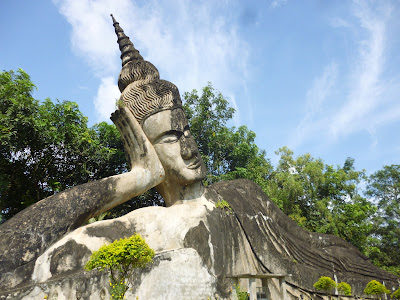De Pakse a Champasak hay 38km, de los cuales treinta por una
carretera de peaje nueva y sin tráfico. Para llegar cruzamos el Mekong por
primera vez, después de días del lado este.
La etapa fue un paseo al atardecer, entre arrozales, niñ@s
saliendo de la escuela, y campesin@s cosechando. Ha sido sin duda lo mejor que
hemos hecho en bici, y lo recomendamos vivamente.
Para l@s mochiler@s intrépid@s nos parece una buena excursión alquilar una bicicleta en Pakse, ir a Champasak y hacer noche para visitar al día siguiente el templo.
Champasak es un pueblo junto al río con más hoteles que
casas. Tranquilo y agradable, nos gustó mucho más que Pakse. Sorprendentemente tiene
un restaurante italiano cuyos platos hicieron nuestras delicias.
Tras una noche en Champasak, recorrimos los 10km que separan
el pueblo del yacimiento conocido como Wat Phu. Declarado patrimonio de la
humanidad por la UNESCO, el conjunto es bastante decepcionante aunque las
vistas son magníficas. Las escaleras de piedra son muy bonitas mezcladas con
las raíces de los árboles pero no son aptas para todos los públicos,
especialmente bajo el sol.
Lo mejor de nuestra visita al Wat Phu fue conocer a Talia y
Ricky, una pareja americano-irlandesa
que enseñaba inglés en China antes de salir a la aventura. Cuentan sus
peripecias en su blog, muy divertido, http://2feetoutthedoor.blogspot.com/
.
There are
38km from Pakse to Champasak, of which thirty are along a new toll road without
any traffic. To get there we crossed the Mekong for the first time, after days
in its eastern shore.
The stage
was a nice stroll, in between rice fields, kids going out school and farmers
sowing. It has been without a doubt the best part of our cycling trip, and we
really recommend it. For intrepid backpackers we think it can be a nice trip to
rent a bicycle in Pakse, go to Champasak and spend the night there to visit the
temple on the next day.
Champasak
is a village next to the river with more hotels than houses. Pleasant and
relaxed, it was much nicer than Pakse. Surprisingly there is an Italian restaurant
whose dishes we really enjoyed.
After one
night in Champasak, we did the ten kilometres to the archeological site known
as the Wat Phu. Declared a world heritage site by the UNESCO, the compound is a
quite disappointing even if the views are magnificent. The stone staircases are
really beautiful mixed with the trees’s roots even if they are not everyone,
and much less under the sun.
The best
part of our visit was meeting Talia and Ricky, an irish-american couple that
taught English in China before going out for the adventure. They tell about
their journey in their blog, very funny, http://2feetoutthedoor.blogspot.com/ .




















































